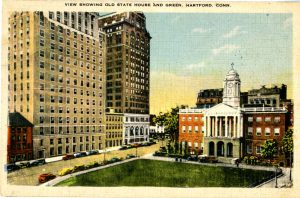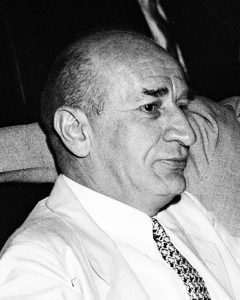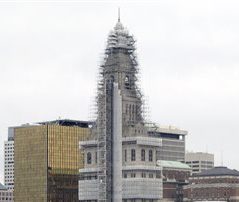The Jewish Community of Hartford (cont)
By: Jackson Russo
The Jewish community in Hartford, Connecticut during the early 20th century played a very important role within the city. They helped layout the infrastructure and groundwork that aided in the development of Hartford as a city and state capitol. The Jewish community played in integral role in both Hartford’s economy and politics during the early 20th century.
The Old State House and Green, Hartford

View showing the Old State House and Green, Hartford. Several office buildings are visible on Central Row to the left: The Hartford Trust Company and The Travelers Insurance Company. Automobiles are parked on Central Row.
The three-story Federal style brick government building with a domed cupola with a clock has a balustrade that surrounds the roof. Doric columns support a pediment over a second-story porch, supported by three arches. The Old State House, erected in 1796 following designs by Charles Bulfinch. From 1878 to 1915, it served as Hartford's city hall.
Historic/Current Address: State Street (Hartford, Conn.)
Political Interests
According to Sandra Becker and Ralph Pearson, during the years of 1860 and 1915, Hartford saw 59 members of its City Council come from the city’s Jewish community. This trend carried on after 1915, after the City Council was disbanded in favor of a different form of local government. As the city’s total population grew along with the city’s Jewish population, the city saw more Jews in politics, as well as them coming from a wider range of areas within the city itself. A couple relatively well known politicians from this time period would be Nathan Schatz and Herman P. Kopplemann. The former was an ethnic and community leader elected to the position of alderman in 1919, going on to become a prosecutor and eventually a judge. Mr. Kopplemann served as an alderman from 1904 to 1912, during this time he gained the title of “Father of the East Side” for his support of the Jewish community who resided mainly in the east side of Hartford. Kopplemann went on to become a State Representative and eventually was elected to the U.S. House of Congress as the first Jewish Representative from Hartford.
By the end of the beginning of the 20th century in Hartford, the city’s Jewish community made up a huge portion of the city’s economy. If the community did not directly stimulate growth in some aspect, it created an environment which enabled that growth. They played the role of the vendor and merchant, selling nearly everything from tobacco to groceries, as well as served in social, cultural, and health and recreational organizations within the city. The community even worked their way into the city’s political arena, securing positions of power and helping both the city and their own community move into the future. Becker and Pearson summarize Hartford’s Jewish community’s motives and accomplishes well by stating that the community worked to “integrate into the community’s institutional and cultural life with the equally strong commitment to retain a separate identity.” The Jewish community of Hartford worked towards bettering their lives within their new home and in the process, worked to better their new home itself.
Herman P. Koppelmann

Herman P. Koppelmann, former State Representative, Hartford City Councilmen, and member of the U.S. House of Representatives.
